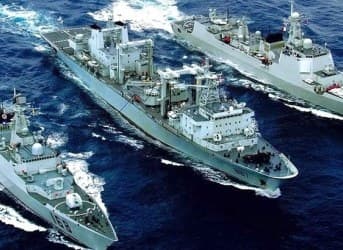While the Western press is fixated on both recent North Korean nuclear tests and Beijing’s recent skirmishes with Japan over the Senkaku (“Diaoyu” in Chinese) islands, other maritime issues have developed further south, where China is involved in sovereignty disputes over the Spratly islands’ 750 islands, islets, atolls, cays and outcroppings with the Philippines, Taiwan, Vietnam, Malaysia and Brunei.
Beijing is bolstering its claims with ancient Chinese maps, despite the 2002 "Declaration on the Conduct of Parties in the South China Sea," designed to ease tensions over the archipelago.
Now, no less an authority than the U.S. government’s Energy Information Agency has waded into the dispute over the potential riches at stake.
The EIA’s updated “South China Sea” brief, issued on 7 February, after noting, “The South China Sea is a critical world trade route and a potential source of hydrocarbons, particularly natural gas, with competing claims of ownership over the sea and its resources,” goes on to add, “EIA estimates the South China Sea contains approximately 11 billion barrels of oil and 190 trillion cubic feet of natural gas in proved and probable reserves.”
The silver lining here?
“Conventional hydrocarbons mostly reside in undisputed territory.”
Searching for yet more optimism, the EIA estimates are far below those of the U.S. Geological Survey, which calculates that the South China Sea may contain roughly 28 billion barrels of oil, even as the Chinese government calculates that the South China Sea region contains nearly 200 billion barrels of oil.
No one knows for sure, especially as the Chinese Navy harasses and chases off foreign survey vessels.
What is certain is that the EIA’s modest observations will only strengthen the multinational South China Sea disputes, as even a modest 11 billion barrels of oil, as opposed to 28 or even 200 billion barrels, is still hard to walk away from.
Throwing yet more oil on troubled waters, the EIA reported that three months ago the Chinese National Offshore Oil Company (CNOOC) estimated the area holds around 125 billion barrels of oil and 500 trillion cubic feet of natural gas in undiscovered resources, although independent studies have not confirmed this figure.”
Will negotiations save the day? The EIA reported, “Rather than attempting unilateral exploration and production (E&P) activities in disputed territory, several countries have opted to cooperate in the South China Sea. Malaysia and Brunei settled territorial disputes in 2009 and have partnered to explore offshore Brunei waters. Thailand and Vietnam have jointly developed areas of the Gulf of Thailand, despite ongoing territorial disputes. These success cases contrast with the parts of the South China Sea contested by multiple parties, which have seen little energy development.”
Down the road, besides the Spratlys, China occupies some of the South China Sea’s Paracel Islands, which it seized in 1974 but are still claimed by Vietnam and Taiwan, along with a territorial dispute with Indonesia over the South China Sea’s 272-island Natuna archipelago, 150 miles northwest of Borneo.
The future?
The EIA, hardly alarmist, concludes, “The South China Sea historically has been a source of conflict among its states.”
On 11 February the Filipino Department of Foreign Affairs Assistant Secretary Raul Hernandez, told reporters that Manila hoped that China would make an official response to the arbitration case it filed before a tribunal under the 1982 United Nations Convention on the Law of the Sea, before maintaining that the case would move forward should China refuse to do so, remarking, “We are hoping that by the deadline, they would be able to officially notify us and reply to our notification that we have submitted to them earlier.” By invoking UNCLOS, the Philippines hauled China to the UN arbitral tribunal in the hope of compelling Beijing to respect Manila’s 200-mile UNCLOS guaranteed maritime exclusive economic zone (EEZ) and adjacent continental shelf.
Bolstering Manila’s determination is the fact that the U.S. is negotiating to return to its former military bases in the Philippines at Clark airfield and Subic Bay.
With billions of barrels of oil at stake, gentlemen - place your bets.
By. John C.K. Daly of Oilprice.com


















